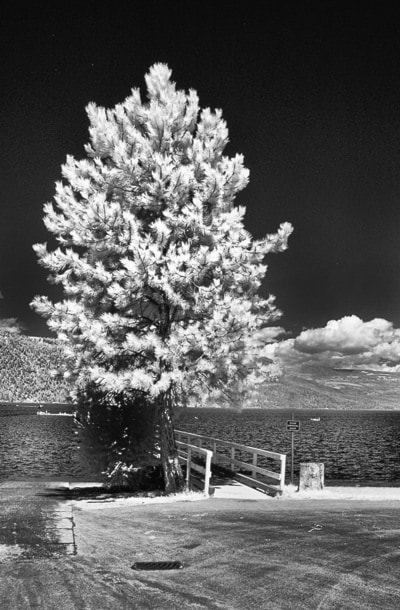For several days I have been listening to fellow photographers complain about the hot, bright days here in the interior of British Columbia. When they stop by my shop I welcome them with the question “What have you been out photographing?” But mostly I have been hearing “Naw, I haven’t been doing anything. It’s too hot, muggy, and the light is crappy anyway. I can’t wait till September.”
Well, I must agree that my personal photography also stagnated during these dog days of summer. I prefer summer’s end, fall colours and I suppose, the cooler weather.
I had already spent a day doing stuff inside so when my wife mentioned that she wouldn’t mind a quick trip to the grocery store, I grabbed a DSLR I had converted for infrared and we headed out. The closest town to our place is the small lake-side community of Chase, B.C. I thought the lake and bright sky would be perfect for a camera that only sees infrared light, plus I knew it would be nice and cool by the lake.
I have a camera that has been modified to only see infrared light and in my experience those harsh bright summer days are perfect for infrared image making. Infrared (IR) light is light that has longer wavelengths on the red edge of the spectrum and is invisible to human eyes.
Here is some trivia: In 1800 William Hershel described the relationship between heat and light and let the world know about his discovery of the existence of infrared light in the electromagnetic spectrum.
The sensors for digital cameras are sensitive to more than just the visible light spectrum. This causes problems with colour balance, so camera manufacturers place a filter in front of the sensor that blocks the infrared part of the spectrum that only allows visible light, and not infrared, to pass through.
The modification is accomplished by removing that filter, and then installing one instead that blocks visible light, allowing mostly infrared light to reach the camera’s sensor.
The camera still functions normally, with full auto focus and auto exposure, except that it’s now able to record the infrared wavelengths that are just beyond what the human eye is capable of seeing. When infrared photographs are produced as black and white the photographs show trees with glowing white leaves and black skies opening up new visual opportunities for photographing the world around us.
Many think of infrared photography as the stuff of military night reconnaissance, or, as frequently portrayed in movies, as aerial thermal imaging that finds the bad guys. With thermal imaging one sees the heat the subject is producing, however, infrared as photographers use it, with our modified cameras is about capturing the light or radiation that is reflected off a subject and doesn’t involve thermal imaging at all.
I wander, and photograph pretty much anything, choosing different angels to see how the light would react. Some subjects don’t work very well with infrared, so I just experiment, take lots of pictures and hope for the best. Everything appears normal through the camera’s viewfinder and because so much light reaches the sensor on a sunny day one can use high shutter speeds and so it is easy to hand hold while exposing a picture.
I like infrared photography and have made prints from infrared film since the beginning of my career in photography, when infrared film had to be loaded and unloaded in complete darkness. Because dark red filters had to be used on the lens subjects were very hard to see through the viewfinder. When digital cameras were introduced all this changed.
For those interested, there is lots of information to be found on the internet. IR photography opens up a new visual dimension for the photographer willing to dust off that old DSLR and get it converted to an infrared camera.
These are my thoughts this week. Contact me at www.enmanscamera.com or emcam@telus.net. Stop by Enman’s Camera at 423 Tranquille Road in Kamloops. And if you want an experienced photographer please call me at 250-371-3069. I also sell an interesting selection of used photographic equipment.
